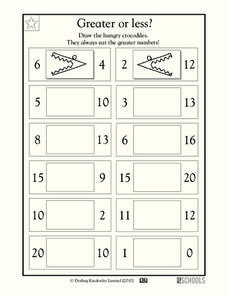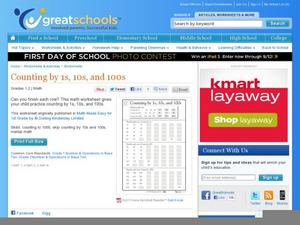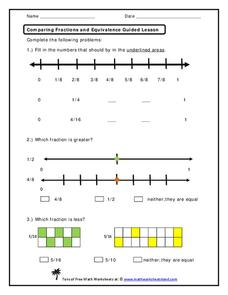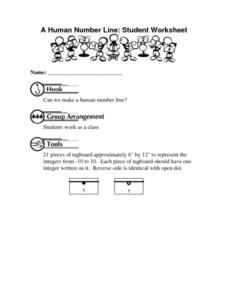Curated OER
Most and Least
Which one has the most? Each row has three sets of identical objects, and scholars compare the sets to determine which has the most or the least (they find the most for the first four and the least for the last four). One example is...
Curated OER
Identify Patterns
To complete these number patterns mathematicians must determine by what number each is constantly increasing. However, this isn't your typical skip counting; scholars count by numbers like 18, 60, and even 101 to fill in the missing...
Curated OER
Counting by 3s, 4s, and 5s
Can learners recognize the pattern in these number sequences? Here's a hint: it's skip counting by either three, four, or five. There are three examples at the top demonstrating each of these, and scholars complete 15 number sequences to...
Curated OER
Hopping by 2s
Hop to it! Young counters practice skip counting by two using illustrations of animals hopping from place to place. Each image shows a number sequence and scholars draw in the path as they move from number to number. Encourage them to...
Curated OER
Identifying Patterns
Explore number attributes and skip counting through patterns! Scholars find the pattern in each of these sequences and continue it by writing in the remaining values. They count consistently by various intervals, sometimes forwards and...
Curated OER
Greater or Less?
These crocodiles are hungry for the biggest numbers they can find! This is a fun way to illustrate number comparison; use crocodile mouths as the greater than and less than symbols. There are two examples (with teeth and eyes included)...
Curated OER
Learning 10 - Write the Word
Focus on the number 10 as part of a series of worksheets for young counters. First, they trace the word ten and print it once or twice on their own. Next, learners draw 10 bottles onto an image of a brick wall and examine sets of bottles...
Curated OER
Identifying Patterns
Although this fractions exercise may seem difficult at first, it's really quite simple and intended for beginners to mixed numbers. Scholars complete 15 number sequences by adding two or three mixed numbers or decimal numbers. However,...
Curated OER
Counting Forward or Back
What comes next? Young counters follow the stone path to each house, filling in numbers in a sequence as they go. Some of these move forward and some backward, but all progress by ones. Learners start with given numbers and then follow...
Curated OER
Learning 1 - Write the Word
Let's start from the beginning! Young counters complete activities focused on the number one to solidify their understanding of its value. First, they trace its word form and then try it on their own (maybe more than once, even). Next,...
Curated OER
Identifying Patterns
Find the pattern! Eighteen number sequences challenge scholars to identify and complete the pattern, adding at least four digits to the given numbers. All the sequences here involve skip counting by various single-digit numbers,...
Curated OER
Hopping by 2s, part 2
Explore skip counting by twos with young mathematicians as they complete these engaging activities. First, they color in squares to represent counting by twos in an even sequence and an odd sequence. Next, they connect dots (by twos) to...
Curated OER
And 2 More Makes...
If we add two more, how many does it make? Before youngsters start with addition, give them this clearly worded exercise to help them grasp the concept. Kindergartners focus on the term more as they examine four sets of flowers, draw two...
Curated OER
Counting Up and Down
These number sequences are missing quite a few digits; can your scholars determine some of them? Because learners aren't filling in every blank, they must utilize mental math to determine only the few numbers indicated. They count...
Curated OER
Counting Out Loud
These number sequences are quite fun to look at! Beginning counters complete six of them as they say and write in the numbers. They count only by 1s, however some of these move from greatest to least. The highest number here is 20. Once...
Curated OER
Counting by 1s, 10s, and 100s
These sequences are missing numbers and require some skip counting to complete. Scholars finish rows of numbers first counting by 1s, then 10s, and finally 100s. Each has three given numbers to get them started, and they fill in five...
Curated OER
Counting by 3s, 4s, and 5s
Skip count along the mushrooms to complete these number sentences which give young scholars an introductory look at addition and subtraction. Starting from five double-digit numbers, they subtract or add by threes, fours, and fives to...
Curated OER
Patterns
Follow the pattern to find what comes next. Youngsters analyze shape patterns to continue the sequence in the provided space. The three patterns increase in difficulty, and then scholars have a chance to create two of their own....
Curated OER
What Shapes Can You See?
This clown is missing some things, and young counters sequence single-digit numbers to complete this juggling act. They connect four separate connect-the-dots sequences to create two triangles and two squares, then complete three more...
Curated OER
And 4 More Makes...
How many will there be if we add four more? Scholars examine sets of sports balls, drawing four more and totaling them. Sums in these four problems don't exceed 10, and the numbers 0-10 are written below for learners to reference as they...
Curated OER
Comparing Fractions and Equivalence
There are a few ways to practice fraction skills here, and they will all appeal to visual learners. First, mathematicians fill in blanks in two fraction number sequences. Next, they analyze two fractions marked along a number line to...
Curated OER
A Human Number Line: Student Worksheet
Kids are challenged to make a human number line. They line up, holding numbers from -10 to 10. They then add and subtract both positive and negative numbers, using themselves as the numbers on the number line. This is a great way to...
Curated OER
What Happens Next: 2
What happens next? That is a great question that requires learners to think about the sequence of events then make a prediction. They assess the pictures on the left and draw lines to the pictures on the right that show what will happen...
Curated OER
What Happens Next? 1
Knowing how to sequence events means you have to know what happens before and after. Little ones draw a line from four before images to the images that show what happened next. This is a good challenge for your youngest learners.

























